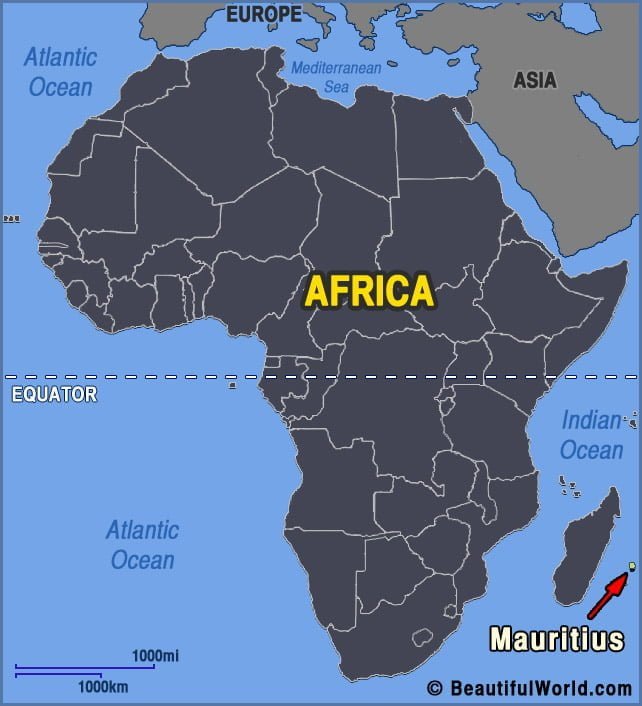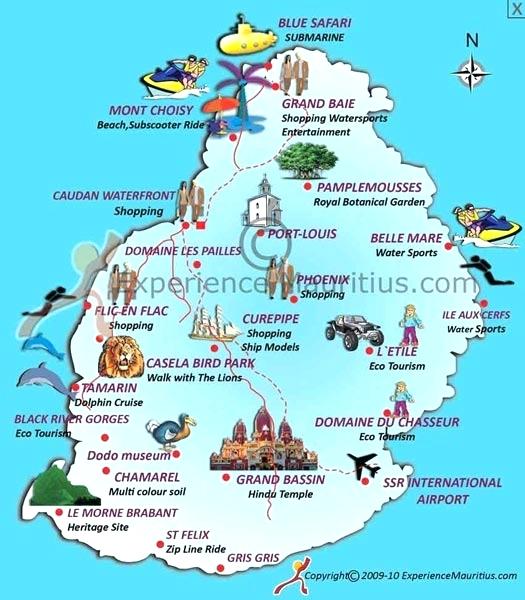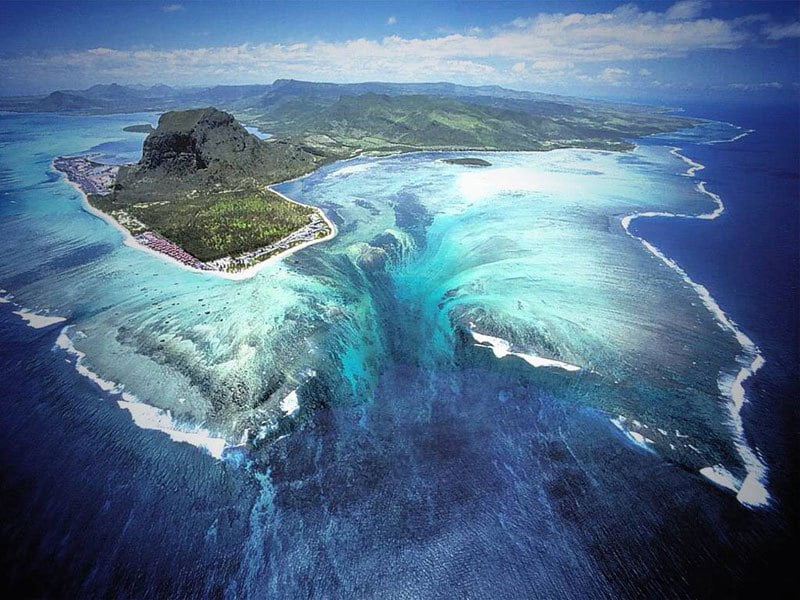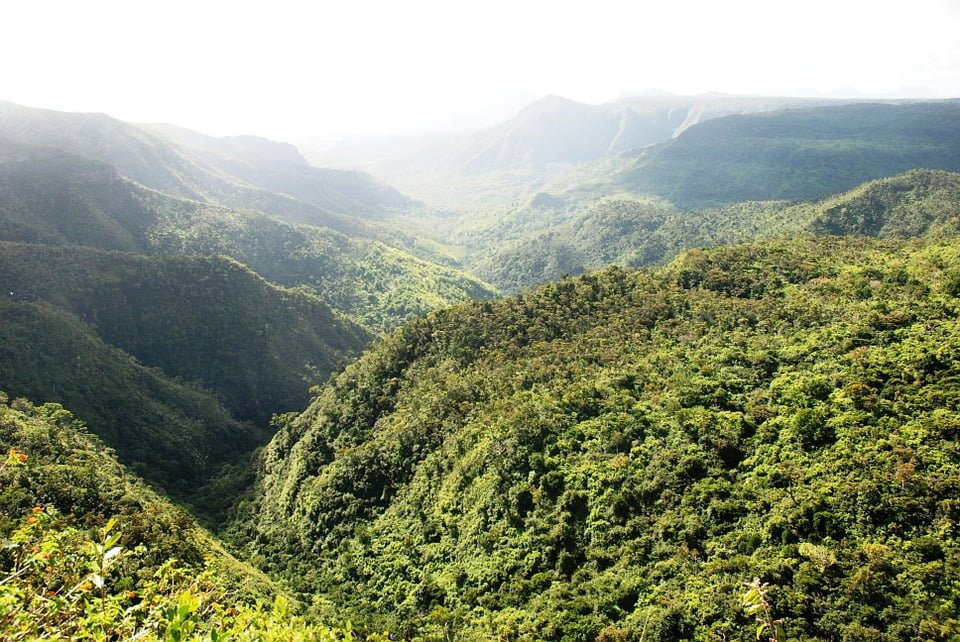Where is Mauritius?
Mauritius or, to give it its official name, the Republic of Mauritius (in French: République de Maurice) is an island nation in the Indian Ocean approximately 560 km east of Madagascar. This nation forms part of the Mascarene Islands and is mainly based on the islands of Mauritius and Rodrigues, some 560 km to the east, along with various other islands including Agaléga and St Brandon and numerous uninhabited islets. Mauritius lies within the tropics being located just north of the Tropic of Capricorn. The Mauritian time zone is GMT + 0.4 (UTC + 0.4).
Mauritius Map
Mauritius is 2000km off the South Eastern coast of Africa further from the continental mainland than Madagascar as you can see from the map below. There is another Island of a similar size just off its South West tip. This is the Island of Reunion and it is part of France rather than Mauritius. The small Island of Rodrigues is about 5 times further away from Mauritius to the East, however, this is actually part of Mauritius.

Mauritius Island is by far the largest land mass in this island group. The map of Mauritius below highlights some of the main places, features and sights. You can click on the map points for more information about each and you can double click on the map to zoom in and drag the map to move around.

The Mauritius Flag
Mauritius gained independence from the UK in 1968 at which time a new national flag was established. This is known as “Les Quatre Bandes” (the four bands) and it comprises four horizontal bands coloured, from the top down, red, blue, yellow and green. The colours have symbolic meanings with red representing the fight for independence, blue referring to the Indian Ocean, yellow represents the new light of independence and green is shown as a tribute to the year-round agricultural fertility. For maritime use, a red (private) or blue (state) ensign will be flown. These flags incorporate the national flag in the corner in addition to the Mauritius coat of arms.
Mauritius Island
For most visitors, Mauritius Island is the primary destination and it has been described as the prototype upon which heaven was based! Whereas the Republic of Mauritius has a land area of 2040 sq km, this island covers just 1874 sq km which, for comparison, is just a little less than Tenerife (2008 sq km) and a little more than the Isle of Skye (1659 sq km). Mauritius is perhaps best known for its wonderful white beaches and the island boasts over 150 km of beaches around its shoreline.

Leading away from the beaches, the fertile, gently sloping land is widely planted with sugar cane and forested areas including ebony and eucalyptus trees. The mountain ranges of Mauritius are volcanic in origin and the island features a broken ring of rugged mountains and a lofty inland plateau area. There are many spectacular pools and waterfalls often with the opportunity for taking a dip! The sea of course is never far away and the seas around Mauritius are simply stunning with sheltered lagoons set within the world’s third largest coral reef.
Mauritius Airport
Mauritius has a single airport located at Plaine Magnien, 9 km from Mahebourg in the south-east of Mauritius Island. This is approximately 48 km from the capital city of Port Louis. The airport is called the SSR Mauritius Airport or, to give it its full name, the Sir Seewoosagur Ramgoolan Mauritius Airport, being named after the independent country’s first leader who is regarded as the father of the free nation. The airport’s IATA code is MRU which you can use below to investigate suitable flights.
The airport has a single main runway for international flights but those expecting to find some kind of ramshackle aerodrome will be surprised to find that this is a truly world class facility and the winner of many awards. Many major brands maintain a presence at the airport and there is even a dedicated space for prayer or meditation, which can be found just behind the Hugo Boss outlet. In many cases, airport transfer will be arranged by tour operators but it is worth checking this and pre-booking transport if needed to avoid any unnecessary delays.
The People of Mauritius
Even more than the natural beauty of Mauritius, it is the people of Mauritius, that really make this one of the most wonderful places in the world. So who exactly are the Mauritians? There is no single answer as there are many different ethnic and cultural backgrounds. None of the Mauritians can be regarded as being indigenous to these islands and all can trace their family roots elsewhere. The largest group, about two thirds of the population, are of Indian origin, their ancestors arriving as indentured labourers after the abolition of slavery in the 19th century. The Creoles are the next largest group at 27% but their forefathers were far from willing immigrants being brought in from Africa and Madagascar to labour in the sugar plantations. Around 3% of Mauritians are descended from Chinese merchants with 2% being French Mauritians. The French of course were the first nation to effectively colonise Mauritius and most places clearly have French names. Mauritius was named “Isle de France” during the period of French rule.

The Language(s) of Mauritius
Mauritius is truly multicultural and multilingual and for most visitors, it seems strange that so many different languages can be in everyday use. English is the official language but rather bizarrely, few Mauritians are fluent in spoken English. The language most widely used on a daily basis is Mauritian Creole which is heavily influenced by French. The Creole form of greeting is “Bonzour” rather than “Bonjour”. English is a major written language and is also the language used in schools. In the home environment, many people use their ancestral tongue and French is regarded as an upper-class language often used in the arts. Many other languages are in common use including Bhojpuri, Hindi, Cantonese, Urdu, Tamil, Marathi and Hakka. Mauritius is sometimes described as a cultural melting pot but there is little or no evidence of any blurring of the boundaries between the many different groups and a friendly and tolerant coexistence can be observed. Religious freedom is also a feature of Mauritian life with Hinduism being the most widely followed faith followed by Christianity, Islam and many others.
Cities of Mauritius
Mauritius has a population of around 1.3 million and its largest cities, by population, are Port Louis (capital), Beau Bassin, Vacoas, Curepipe and Quatre Bornes.
Visiting Mauritius
Visitors to Mauritius can be assured of a warm welcome. Its beaches are world-renowned and further inland, the central plateau offers incredible views over the island. Water sports feature highly on many visitors lists but Mauritius is also the home to world-class golf and the famous Champs-de-Mars horse races. Many international airlines have flights to Mauritius and no visa is required. The local currency is the Mauritian Rupee and currency exchange facilities are widely available including at the airport where ATM machines can offer this service. Occasionally some establishments such as hotels or restaurants may accept payment by foreign currency but this is the exception rather than the rule and Mauritian Rupees are almost always required.
Mauritius has much to offer and, although some visitors choose to simply stay at their chosen resort, many others prefer to explore this enchanting country. A boat trip to Reunion Island is just one of the many aquatic adventures and those who enjoy hiking should consider visiting Tamarin Falls in the south-west of the island which is a collection of spectacular waterfalls well worth the effort. Rare plants and birds can be observed at Black River Gorges, the country’s sole national park and a more formal example of tropical gardening can be found at the Pamplemouses Royal Botanical Gardens. Mauritius is famous for having been the only recorded home of the now extinct dodo but it has many other rare and endemic species of plants and animals. On the tiny Ile aux Aigrettes, can be found the giant tortoise, pink pigeon and Mauritius kestrel.

For those looking for the true spirit of Mauritius, the Sega music and dance has its origins back in the dark days of slavery and Mauritian food is influenced by many different countries and cultures.
Mauritius has two UNESCO World Heritage sites both dedicated to the injustices of the past. In the extreme south-west, the Le Morne Cultural Landscape, featuring the huge Le Morne Brabant monolith is a reminder that this rock and its almost inaccessible caves provided refuge for runaway slaves. Further up the coast at Port Louis’s Bay of Trou Fanfaron, stands the indentured labour camp of Aapravasi Ghat which was the reception point for all of the Indian labourers brought in to take the place of the slaves.
The Underwater Waterfall of Mauritius
It seems that the spectacular scenery of Mauritius is not limited to land above sea level. Aerial photographs of the shoreline around Le Morne at south-west of the island seem to show the waters of the Indian Ocean plunging over a cliff edge and tumbling down into the abyss below. Although some reporters have simply dismissed such images as being optical illusions, the cliff edges and the immense submarine rift are completely genuine. The only illusion is that what appears to be torrents of falling water, is actually sand and silt being moved by the tides and ocean currents until falling down to the ocean floor. The crystal clear shallow waters immediately above this gigantic gorge simply go unnoticed allowing the seabed to appear to be the surface. It can only be observed from the air and helicopter and seaplane trips are sometimes available.

Seven Coloured Earths, Chamarel
In the south-west of Mauritius are the Chamarel plains. There is a small section of sand exposed to the air which has a spectacular variation of colour. The different colours separate giving the dunes a striped appearance. Despite the area, experiencing tropical rainfall the dunes never seem to erode.

Mauritius Resorts
One of the great things about Mauritius is that the whole of the island can be explored by those who wish to venture away from their holiday base but with so many beautiful resorts there is a temptation to just stay put and enjoy the immediate surroundings. A huge range of accommodation is available including some of the finest hotels but some visitors may prefer simpler surroundings. Most of the resorts are to be found close to the beaches where the sheltered lagoon waters provide safe swimming and snorkelling. The southern shore tends to have slightly fewer resorts but all of the beaches are simply incredible. Mauritian hospitality is legendary and many visitors enjoy experiencing the local culture but the all-inclusive option is becoming increasingly popular with many hotels offering this type of deal. Knowing that everything is paid for allows visitors to concentrate on the important aspects of enjoying their holiday.
Mauritius Hotels
Mauritius attracts visitors from around the world and there is no shortage of hotel accommodation. Luxury, boutique and budget hotels can be found and it is always worth being on the lookout for any special deals that hotels may be offering as this may save money or allow for a hotel upgrade, or both! At the top end of the market, The spa hotels are popular and some also include facilities for golf. The booking of suites or hotel villas gives plenty of space and luxury. The weather may influence the choice of hotel with the east coast tending to be rather more breezy than the west. This can be quite welcome during hot and humid periods. The temperature at higher altitudes tends to be a few degrees lower than around the coasts.
Mauritius Weather
Being situated in the tropics, there is little seasonal difference and Mauritius is pleasantly warm all year round. It does have seasons however but temperatures only vary by around four of five degrees Celsius. Being in the southern hemisphere, the seasons are of course a reversal of those in the northern hemisphere. Mauritius has no wet or dry season and is generally not affected by severe tropical storms. It is well away from the monsoon belt. It does sometimes experience cyclones with some heavy rainfall but such events tend to be short-lived.

Mauritius and Mark Twain
Mauritians delight in reporting that Mark Twain famously extolled the heavenly nature of their land but there remains some doubt about the actual origins of the words in question. Mark Twain was most famous for his creation of the character Tom Sawyer but also penned a travel guide entitled: “Following the Equator” describing his circumnavigation when on his 1895/96 lecture tour. He arrived in Mauritius in 1896 and seems to have been enthralled by its people and their love of their homeland. In his book he writes: “Here the citizen does the talking about the country himself; the stranger is not asked to help. You get all kinds of information. From one citizen you gather the idea that Mauritius was made first, then heaven; and that heaven was copied after Mauritius”. Thus is seems likely that the reference to Mauritius being a prototype heaven may have actually originated from a Mauritian. Of course we shall never know whether such a conversation actually took place but few would disagree with the sentiment!

With all this site seeing. this is a place to be.
do i need a visa to go to mauritius?
No
No a bus ticket would do
From Nigeria do I need Visa to come Mauritius 🇲🇺?
Is it allowed for people from parts of Africa(West Africa) to marry a mauritian?
Absolutely breathtaking. This place is a must to visit !
S